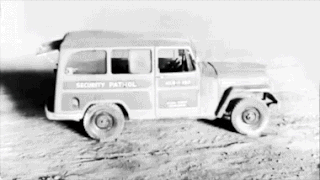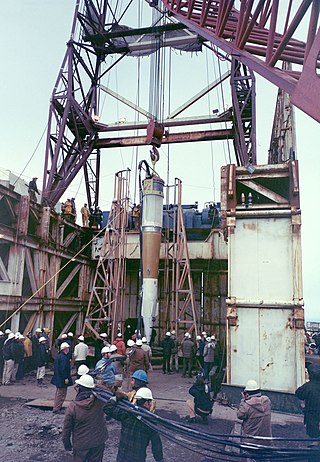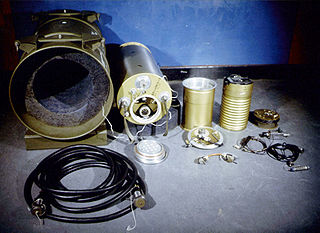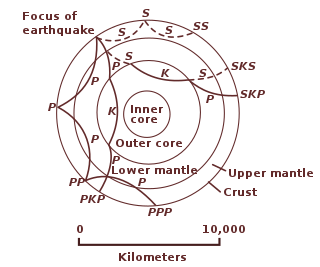Related Research Articles

An earthquake – also called a quake, tremor, or temblor – is the shaking of the Earth's surface resulting from a sudden release of energy in the lithosphere that creates seismic waves. Earthquakes can range in intensity, from those so weak they cannot be felt, to those violent enough to propel objects and people into the air, damage critical infrastructure, and wreak destruction across entire cities. The seismic activity of an area is the frequency, type, and size of earthquakes experienced over a particular time. The seismicity at a particular location in the Earth is the average rate of seismic energy release per unit volume.

Seismology is the scientific study of earthquakes and the generation and propagation of elastic waves through the Earth or other planetary bodies. It also includes studies of earthquake environmental effects such as tsunamis as well as diverse seismic sources such as volcanic, tectonic, glacial, fluvial, oceanic microseism, atmospheric, and artificial processes such as explosions and human activities. A related field that uses geology to infer information regarding past earthquakes is paleoseismology. A recording of Earth motion as a function of time, created by a seismograph is called a seismogram. A seismologist is a scientist works in basic or applied seismology.

A tsunami is a series of waves in a water body caused by the displacement of a large volume of water, generally in an ocean or a large lake. Earthquakes, volcanic eruptions and other underwater explosions above or below water all have the potential to generate a tsunami. Unlike normal ocean waves, which are generated by wind, or tides, which are in turn generated by the gravitational pull of the Moon and the Sun, a tsunami is generated by the displacement of water from a large event.
A nuclear electromagnetic pulse is a burst of electromagnetic radiation created by a nuclear explosion. The resulting rapidly varying electric and magnetic fields may couple with electrical and electronic systems to produce damaging current and voltage surges. The specific characteristics of a particular nuclear EMP event vary according to a number of factors, the most important of which is the altitude of the detonation.

Infrasound, sometimes referred to as low frequency sound, describes sound waves with a frequency below the lower limit of human audibility. Hearing becomes gradually less sensitive as frequency decreases, so for humans to perceive infrasound, the sound pressure must be sufficiently high. Although the ear is the primary organ for sensing low sound, at higher intensities it is possible to feel infrasound vibrations in various parts of the body.

The effects of a nuclear explosion on its immediate vicinity are typically much more destructive and multifaceted than those caused by conventional explosives. In most cases, the energy released from a nuclear weapon detonated within the lower atmosphere can be approximately divided into four basic categories:

Amchitka is a volcanic, tectonically unstable and uninhabited island in the Rat Islands group of the Aleutian Islands in southwest Alaska. It is part of the Alaska Maritime National Wildlife Refuge. The island, with a land area of roughly 116 square miles (300 km2), is about 42 miles (68 km) long and 1 to 4 miles wide. The area has a maritime climate, with many storms, and mostly overcast skies.
Induced seismicity is typically earthquakes and tremors that are caused by human activity that alters the stresses and strains on Earth's crust. Most induced seismicity is of a low magnitude. A few sites regularly have larger quakes, such as The Geysers geothermal plant in California which averaged two M4 events and 15 M3 events every year from 2004 to 2009. The Human-Induced Earthquake Database (HiQuake) documents all reported cases of induced seismicity proposed on scientific grounds and is the most complete compilation of its kind.
A volcano tectonic earthquake or volcano earthquake is caused by the movement of magma beneath the surface of the Earth. The movement results in pressure changes where the rock around the magma has a change in stress. At some point, this stress can cause the rock to break or move. This seismic activity is used by scientists to monitor volcanoes. The earthquakes may also be related to dike intrusion and/or occur as earthquake swarms. Usually they are characterised by high seismic frequency and lack the pattern of a main shock followed by a decaying aftershock distribution of fault related tectonic earthquakes.

High-altitude nuclear explosions are the result of nuclear weapons testing within the upper layers of the Earth's atmosphere and in outer space. Several such tests were performed at high altitudes by the United States and the Soviet Union between 1958 and 1962.
The earthquake bomb, or seismic bomb, was a concept that was invented by the British aeronautical engineer Barnes Wallis early in World War II and subsequently developed and used during the war against strategic targets in Europe. A seismic bomb differs somewhat in concept from a traditional bomb, which usually explodes at or near the surface and destroys its target directly by explosive force; in contrast, a seismic bomb is dropped from high altitude to attain very high speed as it falls and upon impact, penetrates and explodes deep underground, causing massive caverns or craters known as camouflets, as well as intense shockwaves. In this way, the seismic bomb can affect targets that are too massive to be affected by a conventional bomb, as well as damage or destroy difficult targets such as bridges and viaducts.

Underground nuclear testing is the test detonation of nuclear weapons that is performed underground. When the device being tested is buried at sufficient depth, the nuclear explosion may be contained, with no release of radioactive materials to the atmosphere.
The tsunami bomb was an attempt during World War II to develop a tectonic weapon that could create destructive tsunamis. The project commenced after US Navy officer E.A. Gibson noticed small waves generated by explosions used to clear coral reefs. The idea was developed by the United States and New Zealand military in a program code named Project Seal. The weapons concept was deemed feasible, but the weapons themselves were never fully developed or used. A related concept, the bouncing bomb was developed and used in World War II, to be dropped into water as a means to destroy German dams and cause loss of industrial capacity and widespread flooding.

Atomic demolition munitions (ADMs), colloquially known as nuclear land mines, are small nuclear explosive devices. ADMs were developed for both military and civilian purposes. As weapons, they were designed to be exploded in the forward battle area, in order to block or channel enemy forces. Non-militarily, they were designed for demolition, mining or earthmoving. However, apart from testing they have never been used for either purpose.

Cannikin was an underground nuclear weapons test performed on November 6, 1971, on Amchitka island, Alaska, by the United States Atomic Energy Commission. The experiment, part of the Operation Grommet nuclear test series, tested the unique W71 warhead design for the LIM-49 Spartan anti-ballistic missile. With an explosive yield of almost 5 megatons of TNT (21 PJ), the test was the largest underground explosion ever detonated by the United States.

The following outline is provided as an overview of and topical guide to geophysics:
This is a list of different types of earthquake.
An electromagnetic pulse (EMP), also referred to as a transient electromagnetic disturbance (TED), is a brief burst of electromagnetic energy. The origin of an EMP can be natural or artificial, and can occur as an electromagnetic field, as an electric field, as a magnetic field, or as a conducted electric current. The electromagnetic interference caused by an EMP can disrupt communications and damage electronic equipment. An EMP such as a lightning strike can physically damage objects such as buildings and aircraft. The management of EMP effects is a branch of electromagnetic compatibility (EMC) engineering.

The Democratic People's Republic of Korea conducted its sixth nuclear test on 3 September 2017, stating it had tested a thermonuclear weapon. The United States Geological Survey reported an earthquake of 6.3-magnitude not far from North Korea's Punggye-ri nuclear test site. South Korean authorities said the earthquake seemed to be artificial, consistent with an underground nuclear test. The USGS, as well as China Earthquake Networks Center, reported that the initial event was followed by a second, smaller, earthquake at the site, several minutes later, which was characterized as a collapse of the cavity formed by the initial detonation.

A volcanic tsunami, also called a volcanogenic tsunami, is a tsunami produced by volcanic phenomena. About 20–25% of all fatalities at volcanoes during the past 250 years have been caused by volcanic tsunamis. The most devastating volcanic tsunami in recorded history was that produced by the 1883 eruption of Krakatoa. The waves reached heights of 40 m (130 ft) and killed 36,000 people.
References
- ↑ 927N0104A Moscow ZNANIYE-Sila (in Russian) No. 1, Jan 92 p2-13, translated in JPRS Report on Science and Technology, October 1992
- 1 2 Kotlyakov, Valdimir (2010). Natural Disasters - Volume I. Singapore: UNESCO/EOLSS Publishers. p. 116. ISBN 9781848267596.
- 1 2 Foulger, Gillian R.; Wilson, Miles P.; Gluyas, Jon G.; Julian, Bruce R.; Davies, Richard J. (2018). "Global review of human-induced earthquakes". Earth-Science Reviews. 178 (published March 2018): 438–514. Bibcode:2018ESRv..178..438F. doi: 10.1016/j.earscirev.2017.07.008 .
- 1 2 3 "Can nuclear explosions cause earthquakes?". U.S. Geological Survey. n.d. Archived from the original on 12 March 2018.
- ↑ Marghany, Maged (2018). Advanced Remote Sensing Technology for Tsunami Modelling and Forecasting. Boca Raton, FL: CRC Press. pp. 4–21. ISBN 9780815386391.
- ↑ R Clark, Nature, 10 October 1996, quoted in Bulletin of the Atomic Scientists Jan 1997, In Brief section
- ↑ Federation of American Scientists: Address by US Secretary of State at 1997 conference on terrorism
- ↑ Bingham, Eugene (28 September 1999). "Devastating tsunami bomb viable, say experts". The New Zealand Herald . Retrieved 19 November 2011.
- ↑ "MythBusters Episode 60: Earthquake Machine". MythBusters Results. 30 August 2006.
- ↑ "Convention on the Prohibition of Military or Any Other Hostile Use of Environmental Modification Techniques (ENMOD)". United Nations Office for Disarmament Affairs (UNODA). Retrieved 17 September 2023. Page links to text of Convention, which entered into force 5 October 1978.
- ↑ LiveScience: Chavez: US 'Tectonic Weapon' Caused Haiti Quake, 29 January 2010
- ↑ Komsomolskaya Pravda, 30 May 1992, p1, translated in JPRS Report on Science and Technology, 10 June 1992
- ↑ Soica, Mihai (February 9, 2023). "Teoria conspirației de la tribuna Senatului României. Șoșoacă susține că Turcia a fost atacată "cu arme geologice"". Evenimentul Zilei (in Romanian). Retrieved October 15, 2023.